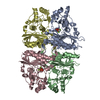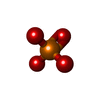+Search query
-Structure paper
| Title | GID E3 ligase supramolecular chelate assembly configures multipronged ubiquitin targeting of an oligomeric metabolic enzyme. |
|---|---|
| Journal, issue, pages | Mol Cell, Vol. 81, Issue 11, Page 2445-2459.e13, Year 2021 |
| Publish date | Jun 3, 2021 |
 Authors Authors | Dawafuti Sherpa / Jakub Chrustowicz / Shuai Qiao / Christine R Langlois / Laura A Hehl / Karthik Varma Gottemukkala / Fynn M Hansen / Ozge Karayel / Susanne von Gronau / J Rajan Prabu / Matthias Mann / Arno F Alpi / Brenda A Schulman /  |
| PubMed Abstract | How are E3 ubiquitin ligases configured to match substrate quaternary structures? Here, by studying the yeast GID complex (mutation of which causes deficiency in glucose-induced degradation of ...How are E3 ubiquitin ligases configured to match substrate quaternary structures? Here, by studying the yeast GID complex (mutation of which causes deficiency in glucose-induced degradation of gluconeogenic enzymes), we discover supramolecular chelate assembly as an E3 ligase strategy for targeting an oligomeric substrate. Cryoelectron microscopy (cryo-EM) structures show that, to bind the tetrameric substrate fructose-1,6-bisphosphatase (Fbp1), two minimally functional GID E3s assemble into the 20-protein Chelator-GID, which resembles an organometallic supramolecular chelate. The Chelator-GID assembly avidly binds multiple Fbp1 degrons so that multiple Fbp1 protomers are simultaneously ubiquitylated at lysines near the allosteric and substrate binding sites. Importantly, key structural and biochemical features, including capacity for supramolecular assembly, are preserved in the human ortholog, the CTLH E3. Based on our integrative structural, biochemical, and cell biological data, we propose that higher-order E3 ligase assembly generally enables multipronged targeting, capable of simultaneously incapacitating multiple protomers and functionalities of oligomeric substrates. |
 External links External links |  Mol Cell / Mol Cell /  PubMed:33905682 / PubMed:33905682 /  PubMed Central PubMed Central |
| Methods | EM (single particle) / X-ray diffraction |
| Resolution | 1.95 - 19.2 Å |
| Structure data |  EMDB-12537:  EMDB-12538:  EMDB-12540:  EMDB-12541:  EMDB-12542:  EMDB-12545:  EMDB-12547:  EMDB-12548:  EMDB-12557: EMDB-12559, PDB-7ns3: EMDB-12560, PDB-7ns4: EMDB-12563, PDB-7nsb: EMDB-12564, PDB-7nsc:  PDB-7ns5: |
| Chemicals |  ChemComp-ZN:  ChemComp-PO4:  ChemComp-MG:  ChemComp-HOH: |
| Source |
|
 Keywords Keywords | LIGASE / GID / CTLH / ubiquitin / E3 ligase / supramolecular assembly / metabolism / gluconeogenesis / cryoEM / HYDROLASE |
 Movie
Movie Controller
Controller Structure viewers
Structure viewers About Yorodumi Papers
About Yorodumi Papers











 homo sapiens (human)
homo sapiens (human)
